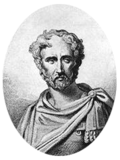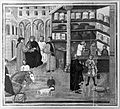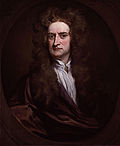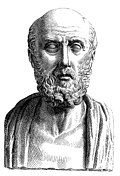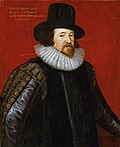Portal:History of science
The History of Science Portal
The history of science covers the development of science from ancient times to the present. It encompasses all three major branches of science: natural, social, and formal. Protoscience, early sciences, and natural philosophies such as alchemy and astrology that existed during the Bronze Age, Iron Age, classical antiquity and the Middle Ages, declined during the early modern period after the establishment of formal disciplines of science in the Age of Enlightenment.
The earliest roots of scientific thinking and practice can be traced to Ancient Egypt and Mesopotamia during the 3rd and 2nd millennia BCE. These civilizations' contributions to mathematics, astronomy, and medicine influenced later Greek natural philosophy of classical antiquity, wherein formal attempts were made to provide explanations of events in the physical world based on natural causes. After the fall of the Western Roman Empire, knowledge of Greek conceptions of the world deteriorated in Latin-speaking Western Europe during the early centuries (400 to 1000 CE) of the Middle Ages, but continued to thrive in the Greek-speaking Byzantine Empire. Aided by translations of Greek texts, the Hellenistic worldview was preserved and absorbed into the Arabic-speaking Muslim world during the Islamic Golden Age. The recovery and assimilation of Greek works and Islamic inquiries into Western Europe from the 10th to 13th century revived the learning of natural philosophy in the West. Traditions of early science were also developed in ancient India and separately in ancient China, the Chinese model having influenced Vietnam, Korea and Japan before Western exploration. Among the Pre-Columbian peoples of Mesoamerica, the Zapotec civilization established their first known traditions of astronomy and mathematics for producing calendars, followed by other civilizations such as the Maya.
Natural philosophy was transformed by the Scientific Revolution that transpired during the 16th and 17th centuries in Europe, as new ideas and discoveries departed from previous Greek conceptions and traditions. The New Science that emerged was more mechanistic in its worldview, more integrated with mathematics, and more reliable and open as its knowledge was based on a newly defined scientific method. More "revolutions" in subsequent centuries soon followed. The chemical revolution of the 18th century, for instance, introduced new quantitative methods and measurements for chemistry. In the 19th century, new perspectives regarding the conservation of energy, age of Earth, and evolution came into focus. And in the 20th century, new discoveries in genetics and physics laid the foundations for new sub disciplines such as molecular biology and particle physics. Moreover, industrial and military concerns as well as the increasing complexity of new research endeavors ushered in the era of "big science," particularly after World War II. (Full article...)
Selected article -

The history of astronomy focuses on the contributions civilizations have made to further their understanding of the universe beyond earth's atmosphere. Astronomy is one of the oldest natural sciences, achieving a high level of success in the second half of the first millennium. Astronomy has origins in the religious, mythological, cosmological, calendrical, and astrological beliefs and practices of prehistory. Early astronomical records date back to the Babylonians around 1000 BCE. There is also astronomical evidence of interest from early Chinese, Central American and North European cultures.
Astronomy was used by early cultures for a variety of reasons. These include timekeeping, navigation, spiritual and religious practices, and agricultural planning. Ancient astronomers used their observations to chart the skies in an effort to learn about the workings of the universe. During the Renaissance Period, revolutionary ideas emerged about astronomy. One such idea was contributed in 1593 by Polish astronomer Nicolaus Copernicus, who developed a heliocentric model that depicted the planets orbiting the sun. This was the start of the Copernican Revolution, with the invention of the telescope in 1608 playing a key part. (Full article...)
Selected image

Part of Charles Babbage's Difference Engine was assembled after his death by Babbage's son, using parts found in his laboratory. The brass parts were machined by the toolmaker Joseph Clement. Babbage never completed his difference engine, partly due to problems with friction and machining accuracy, but also because he kept changing the design. Henry Provost Babbage inherited the pieces following his father's death in 1871, and some years later in 1879 he assembled several working sections of the full machine. Possibly as many as seven assembled sections exist. This portion, in the Whipple Museum of the History of Science of the University of Cambridge, demonstrates how the addition and carry mechanism works.
Did you know
...that the travel narrative The Malay Archipelago, by biologist Alfred Russel Wallace, was used by the novelist Joseph Conrad as a source for his novel Lord Jim?
...that the seventeenth century philosophers René Descartes, Baruch Spinoza, and Gottfried Leibniz, along with their Empiricist contemporary Thomas Hobbes all formulated definitions of conatus, an innate inclination of a thing to continue to exist and enhance itself?
...that according to the controversial Hockney-Falco thesis, the rise of realism in Renaissance art, such as Jan Van Eyck's Arnolfini Portrait (pictured), was largely due to the use of curved mirrors and other optical aids?
Selected Biography -
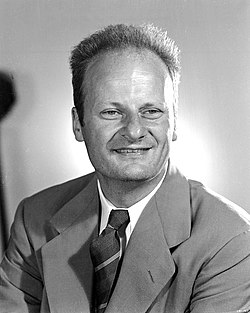
Hans Albrecht Eduard Bethe (/ˈbɛθə/;
German: [ˈhans ˈbeːtə] ⓘ; July 2, 1906 – March 6, 2005) was a German-American physicist who made major contributions to nuclear physics, astrophysics, quantum electrodynamics and solid-state physics, and received the Nobel Prize in Physics in 1967 for his work on the theory of stellar nucleosynthesis. For most of his career, Bethe was a professor at Cornell University.In 1931, Bethe developed the Bethe ansatz, which is a method for finding the exact solutions for the eigenvalues and eigenvectors of certain one-dimensional quantum many-body models. In 1939, Bethe published a paper which established the CNO cycle as the primary energy source for heavier stars in the main sequence classification of stars, which earned him a Nobel Prize in 1967. During World War II, Bethe was head of the Theoretical Division at the secret Los Alamos National Laboratory that developed the first atomic bombs. There he played a key role in calculating the critical mass of the weapons and developing the theory behind the implosion method used in both the Trinity test and the "Fat Man" weapon dropped on Nagasaki in August 1945. (Full article...)
Selected anniversaries
- 1722 - Birth of Petrus Camper, Dutch anatomist (d. 1789)
- 1752 - Birth of Johann Friedrich Blumenbach, German anthropologist (d. 1840)
- 1871 - Death of John Herschel, British mathematician and astronomer (b. 1792)
- 1881 - Birth of Theodore von Kármán, Hungarian physicist (d. 1963)
- 1887 - Death of Jean Baptiste Boussingault, French chemist (b. 1802)
- 1891 - Death of A. E. Becquerel, French physicist (b. 1820)
- 1916 - Death of Karl Schwarzschild, German astronomer and physicist (b. 1873)
- 1918 - Birth of Richard Feynman, American physicist and Nobel Prize laureate (d. 1988)
- 1924 - Birth of Antony Hewish, English radio astronomer and Nobel Prize laureate
- 1930 - Birth of Edsger Dijkstra, Dutch computer scientist (d. 2002)
- 1934 - Death of Orest Khvolson, Russian and later Soviet physicist (b. 1852)
- 1960 - Death of John D. Rockefeller, Jr., American philanthropist and science patron (b. 1874)
- 1963 - Death of Herbert Spencer Gasser, American physiologist and Nobel Prize laureate (b. 1888)
- 1981 - Death of Odd Hassel, Norwegian chemist and Nobel Prize laureate (b. 1897)
- 1987 - The first heart-lung transplant takes place.
- 1995 - In New York City, more than 170 countries decide to extend the Nuclear Nonproliferation Treaty indefinitely and without conditions.
- 1997 - IBM's Deep Blue chess-playing supercomputer defeats Garry Kasparov in the last game of the rematch, becoming the first computer to beat a world-champion chess player.
- 1998 - Nuclear testing: In the Rajasthan Desert, India conducts its first underground nuclear tests and prompting its rival neighbor Pakistan to test its own nuclear weapons.
Related portals
Topics
General images
Subcategories
Things you can do
Help out by participating in the History of Science Wikiproject (which also coordinates the histories of medicine, technology and philosophy of science) or join the discussion.
Associated Wikimedia
The following Wikimedia Foundation sister projects provide more on this subject:
- Commons
Free media repository - Wikibooks
Free textbooks and manuals - Wikidata
Free knowledge base - Wikinews
Free-content news - Wikiquote
Collection of quotations - Wikisource
Free-content library - Wikiversity
Free learning tools - Wiktionary
Dictionary and thesaurus

















